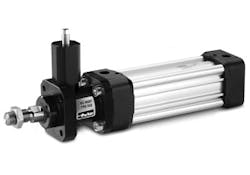Rod locking cylinders are an important component for ensuring safety in the case of compressed air supply failure. For static applications, they can activate to provide emergency holding strength during a power outage or disconnection in air supply. This is important to ensure that heavy machinery does not fall on workers or equipment. In dynamic applications, rod locking cylinders can be used to stop machinery in its tracks.
In dynamic applications, rod locking cylinders can brake cylinders anywhere along their stroke length. Simply by turning off airflow to the cylinder, the operator activates an internal spring-loaded locking device located on the front plate of the cylinder. At zero pressure, the springs release to allow a small piston to move axially. Piston displacement allows a ring of clamping sleeves to rotate along hundreds of tiny steel ball bearings. The rotation moves the clamping sleeves into a locked position around the piston rod.
The springs are reloaded when the air pressure is reactivated beyond a certain threshold. As the piston moves back to its original position, the clamping sleeves rotate back to the unlocked position so that regular motion can be resumed. Clamping sleeves may feature a groove pattern to strongly grip the cylinder piston during locking.
Static rod locking devices, on the other hand, are generally flange-mounted externally onto the front-end cover of the pneumatic cylinder. They may use a cartridge mounted transversally in the rod lock unit to provide the locking force. When there is no signal pressure, the piston rod passes through the cartridge and internal springs push on an over-the-center mechanism to lock the piston. The mechanism uses jaws to clamp onto the piston rod, holding the cylinder firmly in a static position.
But designers beware: If the piston rod is not stationary before the rod lock unit is engaged, the jaws can be worn down and not function properly the next time.
It is also important that designers consider rod locking cylinders as a redundant stopping mechanism for increasing safety. They should consider other technologies as the main components for planned braking or holding.
This article is based off of a blog contributed by Franck Roussillon, EMEA product manager - Automation Actuators, Pneumatic Division Europe, Parker Hannifin Corporation.
About the Author
Leah Scully
Associate Content Producer
Leah Scully is a graduate of The College of New Jersey. She has a BS degree in Biomedical Engineering with a mechanical specialization. Leah is responsible for Hydraulics & Pneumatics’ news items and product galleries.

Leaders relevant to this article:

